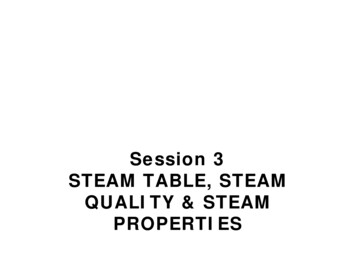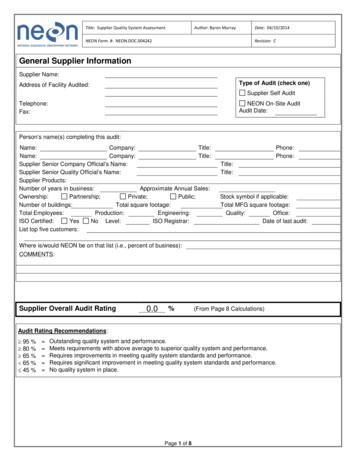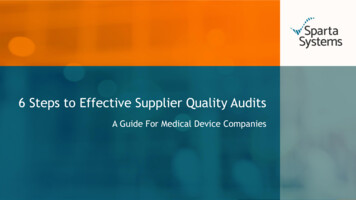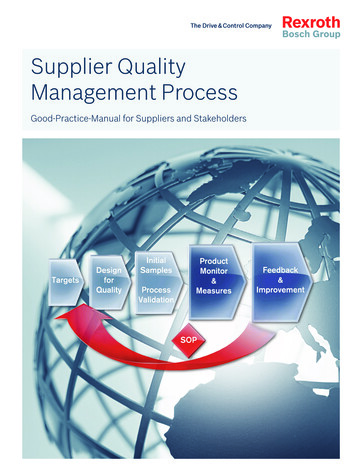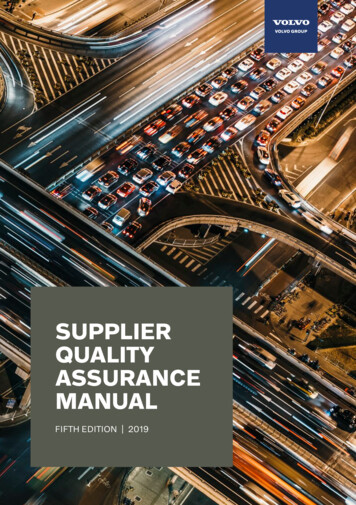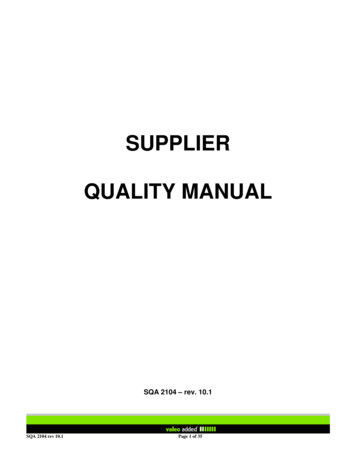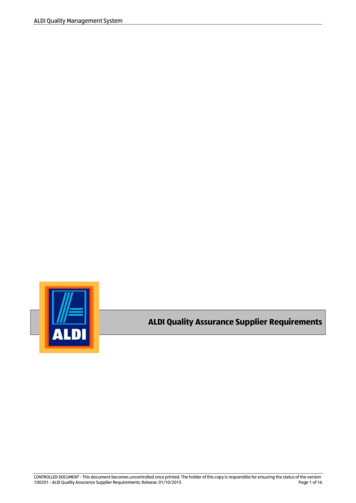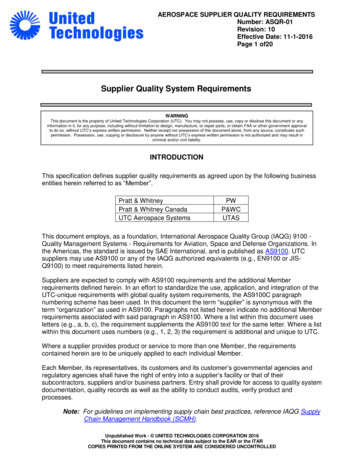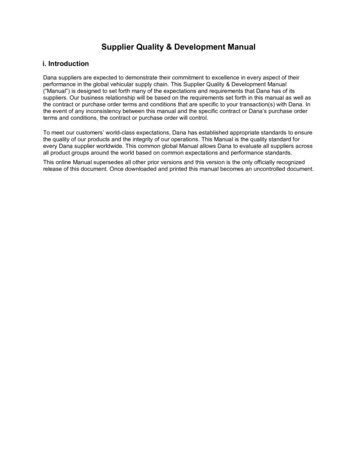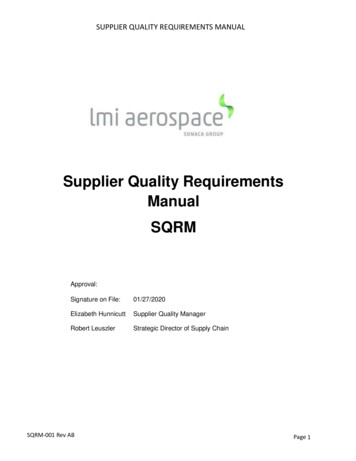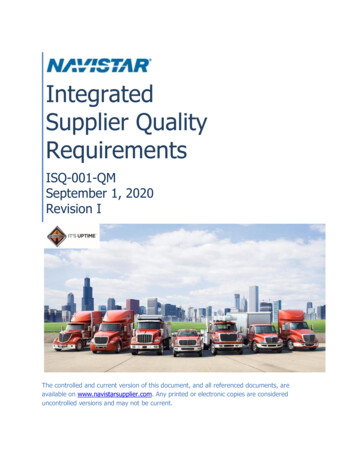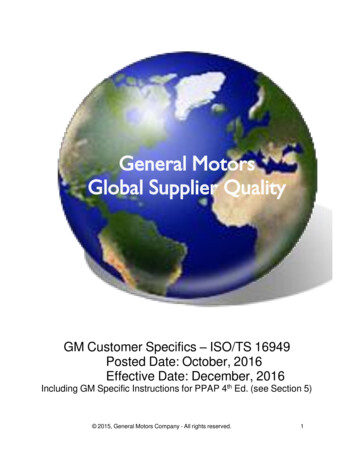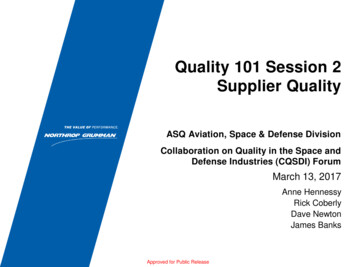
Transcription
Quality 101 Session 2Supplier QualityASQ Aviation, Space & Defense DivisionCollaboration on Quality in the Space andDefense Industries (CQSDI) ForumMarch 13, 2017Anne HennessyRick CoberlyDave NewtonJames BanksApproved for Public Release
Quality 101 Session Two (2:30 – 4:45 pm)Agenda Supplier Quality Process– 2:30 – 2:55 Risk Identification and Mitigation– 2:55 – 3:05 Supplier Evaluation– 3:05 – 3:10 Supplier Approval and Selection– 3:10 – 3:25 Supplier Quality/Mission Assurance Requirements Activity 3:25 – 3:30 Supplier Quality Execution– 3:30 – 3:45 Supplier Oversight– 3:45 – 3:50 Supplier Ratings - Scorecard– 3:50 – 4:05 Actions for Non-conformance - Root Cause Corrective Action Activity 4:05 – 4:40 Summary and Resources 4:40 – 4:452Approved for Public Release
Supplier Quality ProcessApproved for Public Release
Supplier Quality ProcessManagingSupplierRiskClosed Loop System of Checks and Balances Manages Risk4Approved for Public Release
Managing the Risk of External Providers Pre-Award Evaluation Source Selection, approval status, controlled use,Scope of approval – product type Purchase Order Coding for Quality Requirements Periodic reviews of supplier performance including process,products, services conformity, on-time delivery performance– Reviews types include Metrics for Supplier, Readiness Reviews andDiscrepancy Reviews during Qual/ATP Product acceptance – inspections Supplier Ratings– Register of suppliers – approved, conditional, disapproved Actions for non-conformances – Root Cause/Corrective Action5Reference: AS 9100D 8.4 Control of Externally Provided Processes, Product and ServicesApproved for Public Release
Risk Identification and MitigationApproved for Public Release
Managing Supplier Risk Why perform a risk assessment of suppliers What is the risk management process What are sources of supplier risk How to assess risk How to manage risk Mapping risk potential to mitigation strategies7Approved for Public Release
Why Perform a Risk Assessment of Suppliers? It’s a requirement of AS9100 D– “The organization shall identify and manage the risksassociated with the external provision of processes,products, and services, as well as the selection anduse of external providers” Provides a basis for source selections Understanding of efforts to manage the risk– Technical, cost, schedule, sub-tier management Total cost and complexity of an acquisition– Disciplines, effort, level of skills to executeThey Contribute to Our Success8Approved for Public Release
What is the Risk Management Process?1. Identify riskUse Models to segment the supply base bysupplier or productIdentifyRisk2. Assess riskReviewControlsProbability and ImpactAssessRisk3. Choose mitigation strategyMap risks to mitigation strategies unique toeach situation4. Implement controlsImplementControls5. Review controls9Approved for Public ReleaseChooseMitigationStrategy
Potential Sources of Supplier RiskCost vs.CompetencySub-tiersuppliercontrolLoss of criticalskillsScheduleperformanceManufacturingsite changeProcesscontrolQualityperformanceConversion proved for Public ReleaseCounterfeitparts
A Quick View of Risk Assessment Within the aviation, space, anddefense industry, risk is generallyexpressed in terms of the likelihoodof occurrence and the severity of theconsequences A formal risk mitigation processaddresses risks that exceed adefined criteria (such as endangerslife, mission failure, loss offunctionality) Focuses resources on highest riskReferences:DCMA-INST 219 “Supplier Risk Management Through Standard Contract ments/Policy/DCMA-INST-219.pdf11“Risk Management Guide for DoD Acquisition,” (Sixth Edition, Version cs/RMG%206Ed%20Aug06.pdfApproved for Public Release
Methods to Manage Risk Early understanding of risk potential Ensure requirements are complete, accurate, unambiguous, verifiable Kick-off review performed by one or more disciplines depending on complexity Use engineering oversight Understand changes from baseline products Manufacturing readiness reviews Regular product reviews Challenge qualification by similarity Periodic QMS evaluation Customer source inspection / testing Incoming inspection and screening12 Robust testingApproved for Public Release
Segment by Product Classification Who is responsible for engineering? Where the product is in the life cycle? Map product types within the matrix– Quadrant 1 – Build-to-print and Off-the-Shelf– Quadrant 2 – Build-to-print and Development– Quadrant 3 – Build-to-Spec and Off-the-Shelf– Quadrant 4 – Build-to-Spec and Development Apply unique risk mitigation strategiesReference: Aerospace Report No TOR-2011 (8591-18), Supplier Risk Evaluation andControl, June 1, 2011, TOR-201113Approved for Public Release
Product Segmentation:Risk and Mitigation ild-to-printand Off-theShelf Decide appropriatenessof product Create a drawing fromSupplier’s to manageunique pecand Off-theShelfBuild-to-specandDevelopment14 Engineering Software design (dataflows, hierarchydiagrams, datastructures, etc.) Specifies requirementsand buys suppliersstandard product Specifies requirementsSupplier’sResponsibilitySource of Technical Risk Manufacturing processes Standard product lists Re-use of existing code Low technical/moderate quality risk Changes in designs or processes,materials, site Uses Qual by Similarity Control of processes Control of quality Technology Manufacturing capabilityand technology Generates code Performs softwarequalification testing High technical/ high quality risk Assumptions of the supplier’scapabilities or process controls Changes during development Stability of supplier’s technical staff Standard product line Development is complete Configurationmanagement As-Is re-use of existingcode Engineering –reqmts toproof of design Manufacturing capability Code to requirements Low technical/ low quality risk Supplier makes minor changes andqualifies by similarity Supplier changes material Differences in application fromintended use High technical/moderate quality risk Prime must ensure supplier is applyingmature technology (post PDR focus) Supplier’s capabilities need toaccommodate the complexity Supplier’s ability to transition toproductionReference: Aerospace Report No TOR-2011 (8591-18), Supplier Risk Evaluation and Control, June 1, 2011, TOR-2011Approved for Public ReleaseMitigationStrategies Pre-awardevaluation ofsimilarities ofdesign andprocesses Careful reviews Strong processcontrols Engineeringoversight byuse of subjectmatter experts Thorough preawardevaluation
Supplier EvaluationApproved for Public Release
SupplierEvaluationPre-Award ormanceOversight Is the supplier qualified to perform their anticipated work scope prior tocommencing source solicitation and selection or contractualarrangement, including teaming agreements? Qualified suppliers will exhibit four key attributes:1. Compliance to an appropriate, functioning, Quality Management SystemExample: Industry standards, such as CMMI, ISO9001 and AS91002. Possess adequate financial health and historically demonstrates reasonablefinancial stability3. Demonstrated capability, qualifications and technical maturity for the type of workunder considerationExample: Special process validation audits by National Aerospace and DefenseContractors Accreditation Program NADCAP4. Adequate current and future capacity (both within the supplier and the supplier’ssupply chain) to perform the work scope16Approved for Public Release
SupplierEvaluationQuality Management System ceOversight Industry standards CMMI, ISO9001 and AS9100 describe QMS elements–Significant improvements in quality, cost reductions, process repeatability Confirm that QMS certification is not merely “virtual” certifications Review the supplier’s documented procedures and implementation–Including specific methods for the supplier’s control of goods and services from hissub-tier suppliers–Must describe the supplier’s organizational structure and reporting lines, includingclear delineation of responsibilities Scope should include all functions involved– Engineering, development, systems management and integration, production,installation, testing, support, modification and servicing of both the hardware andsoftware of the products and services being procured Special process validation audits by third party entities such as NationalAerospace and Defense Contractors Accreditation Program (NADCAP)17
SupplierEvaluationFinancial Health ormanceOversight Financial stability is essential to a supplier’s stable, predictable anddependable performance Means to identify potential risk, key in times of economic stress Various financial metrics to evaluate a supplier’s financial health–––––Current RatioQuick RatioDebt to EquityReturn on SalesReturn on Equity Credit Risk Monitor (CRM) service integrates several of them into anaggregated score Dun and Bradstreet (D&B) and Equifax offer similar estimate of financialdistress for private firms without publically-available financial dataIncorporate into new supplier qualification & periodic reviews18Approved for Public Release
SupplierEvaluationProcess Capability ormanceOversight Ensures supplier is a good fit for the anticipated work scope Ensures supplier has the tools, processes and infrastructure tosucceed– Capabilities, equipment, personnel, process controls and management systems Ensures robust sub-contractor selection and control Perform by subject matter experts Ensuring the supplier’s product level of technical maturity increases inline with the contract delivery schedule19Approved for Public Release
SupplierEvaluationTechnical Maturity ceOversight Definitions of product technical maturity from the U.S. Department of Defense(DoD), National Aeronautics and Space Administration (NASA), EuropeanSpace Agency (ESA), European Commission (EC) and Oil & Gas Industry, USDepartment of Energy (DOE)– Reference : https://en.wikipedia.org/wiki/Technology readiness level Level 1: Undefined and not capable: No Process, Methods, Tools and/or inappropriatebehaviours. Level 2: Defined and applied but not 100% effective or not applied everywhere in thecompany (capable for low risk products and services) Level 3: Defined, applied and effective: Repeated satisfactory performance capable. Level 4: Performance of proactive improvements towards planned targets, but notsystematically on all processes / areas / products. Level 5: Best in class, continual improvement fully deployed, involving all stake holdersas part of company culture.20 Reference : Supply Chain Management Handbook (SCHM), Section 4.1.3, SupplierSelection & Capability Assessment Model Guidance Notes, http://www.sae.org/Approved for Public Release
SupplierEvaluationCapacity ormanceOversight Evaluate the level at which a supplier is managing their workload– Entire plant– Cell level– Machine level Management of capacity at the lowest level is most desirable Is the supplier using capacity data for long range planning? The Defense Contracts Management Agency (DCMA) guidebookprovides excellent guidelines for pre-award surveys:http://guidebook.dcma.mil/42/prospective offeror.htm21Approved for Public Release
SupplierEvaluationWarning ceOversight Pre-award evaluation elements may uncover indications of potential riskWarning SignsQuality Management System Verification Quality Capacity QMS in-place and working CARS Reliance on QMS certification only Financial Assessment Credit Risk Monitoring (Frisk Score) Equifax Marginal Score Financial RatiosDefense business segment smallSales skewed to commercialCommercial decline/strikeSelf-financing Multiple sub-tier suppliers Work scope outside normal bounds Diminishing sourcesProcess Capability Assessment Capable for anticipated scope Tools, processes and infrastructure Technical Assessment Technical Maturity (TRL)Key personnel changeEmployee turnover rateHigh absenteeismLack of cross training Capacity shortages % Overtime Managing capacity at site vs. cell levelCapacity Long range planningOn-site visits provide valuable insight into supplier qualifications22Approved for Public Release
SupplierEvaluationAssessment Results anceOversight Radar map allows visualassessment of results Expected level is plotted againstactual level for each category Shows strengths and weaknessesof each evaluation category Identifies gaps Accept gaps or decide on actionplan to closeReference : Supply Chain Management Handbook (SCMH), Section 4.1.3, Supplier Selection &Capabilities Assessment, International Aerospace Quality Group, 5-Jul-2013 www.iaqg.org/scmh23Approved for Public Release
Supplier Approval and Selection Elements in the approval process may include but are not limited to: Risk assessmentPre-award assessmentPerformance history for existing suppliersData from certification bodies AS9100 or ISO 9001 third part certification Define who has the authority for approval status decisions and changes Maintain a register of suppliers and their approval status Example:– Approved– Conditional - Findings that need to be corrected but should not precludeapproval but may assign Source Inspection to assure conformance– Disapproved - Findings need
Review the supplier’s documented procedures and implementation – Including specific methods for the supplier’s control of goods and services from his sub-tier suppliers – Must describe the supplier’s organizational structure and reporting lines, including clear delineation of responsibilities Scope should include all functions involved
